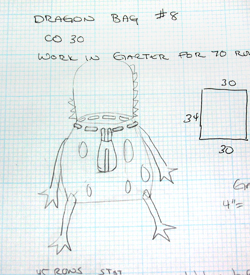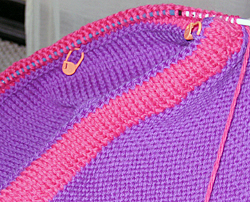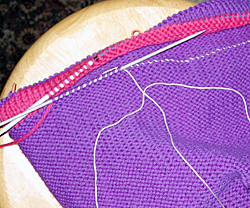What LA has taught me:
When in doubt, make a sequel. Let's just hope this sequel is more "Empire Strikes Back" than "Sperbabies: Baby Geniuses 2"
What the heck am I talking about? Why, my newest project of course. I can't give you too much info, because it's a pattern for a book, but I think I can give you the general gist of the deal.
Here's my notebook sketch

It's a Dragon Bag, which is like my Dragon Hoodie, only inasmuch as it's a Dragon theme, but it's a theme, no less. My favorite part of this bag is the tongue drawstring.
The piece is working up pretty quickly, all things considered, except for the drawstring casing, which I finished and then ripped out when I realized how much I disliked the corners I cut. I started out eyeballing, while whip stitching the hem, which might work well for someone who focuses, solely, on their knitting, but I'm not one of those people, so I plugged away, only to realized that the beginning and ending of my whip-stitched hem were a couple rows away from each other.
Finally, I decided to do what I should have done all along, careful basting for a guideline and a proper grafting of the hem.

Here you can see the halfway grafted hem in pink. If it isn't obvious, the piece is inside-out in this image. The body of the bag is bright purple and the tongue will be pink. I thought it would be cute to work the hem in pink as well to give you the impression of the inside of a mouth.

And here is a detail of how I like to work kitchner stitch with live stitches grafted to the back of knit fabric. First, I run a thread along the row to which I'm planning to graft the live stitches. I did this for two reasons;
1. I have a tendency to lose track of which row I'm working, resulting in a wonky seam.
2. In circular knitting, there's a jog and I want to map out how I'll adjust for it.
Once I've basted along the grafting path, I grab the smallest dpn I can and start moving that row of stitches onto it. This allows me to clearly see my stitches and work a kitchner stitch just like I would for two rows of live stitches. You can probably also tell that I remove my basting as I move stitches onto the dpn.
What the heck am I talking about? Why, my newest project of course. I can't give you too much info, because it's a pattern for a book, but I think I can give you the general gist of the deal.
Here's my notebook sketch

It's a Dragon Bag, which is like my Dragon Hoodie, only inasmuch as it's a Dragon theme, but it's a theme, no less. My favorite part of this bag is the tongue drawstring.
The piece is working up pretty quickly, all things considered, except for the drawstring casing, which I finished and then ripped out when I realized how much I disliked the corners I cut. I started out eyeballing, while whip stitching the hem, which might work well for someone who focuses, solely, on their knitting, but I'm not one of those people, so I plugged away, only to realized that the beginning and ending of my whip-stitched hem were a couple rows away from each other.
Finally, I decided to do what I should have done all along, careful basting for a guideline and a proper grafting of the hem.

Here you can see the halfway grafted hem in pink. If it isn't obvious, the piece is inside-out in this image. The body of the bag is bright purple and the tongue will be pink. I thought it would be cute to work the hem in pink as well to give you the impression of the inside of a mouth.

And here is a detail of how I like to work kitchner stitch with live stitches grafted to the back of knit fabric. First, I run a thread along the row to which I'm planning to graft the live stitches. I did this for two reasons;
1. I have a tendency to lose track of which row I'm working, resulting in a wonky seam.
2. In circular knitting, there's a jog and I want to map out how I'll adjust for it.
Once I've basted along the grafting path, I grab the smallest dpn I can and start moving that row of stitches onto it. This allows me to clearly see my stitches and work a kitchner stitch just like I would for two rows of live stitches. You can probably also tell that I remove my basting as I move stitches onto the dpn.

















<< Home